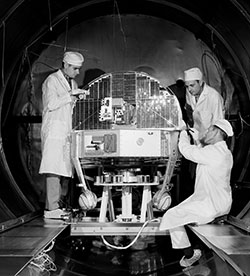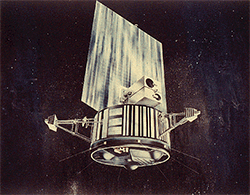Orbiting Solar Observatory Series
Orbiting Solar Observatory Series

The OSO-3 satellite under construction (Credit: Ball Aerospace)

An artist's impression of the OSO-8 satellite in space. (Credit: NASA)
The Orbiting Solar Observatory, or OSO for short, Program was a series of scientific satellites which were primarily intended to study the Sun over its 11-year cycle. Eight nearly identical satellites were successfully launched between 1962 and 1975.
Lifetime: March 1962 (first launch, OSO-1) - October 1978 (last satellite, OSO-8, ceases operation)
Portion(s) of spectrum studied: ultraviolet, X-ray, gamma ray (
Country (primary): United States
Primary Science
The OSO satellites were designed to study the Sun in ultraviolet and X-ray light through an 11-year cycle. In particular, they were designed to measure the solar electromagnetic radiation ultraviolet, X-ray and gamma ray.
Instruments
Each satellite carried a slightly different payload with some combination of ultraviolet, X-ray and gamma-ray spectral capabilities. Use the links from each spacecraft listed below to read about the specific instruments in more detail.
OSO 1
Lifetime: March 1962 - August 1963
Science Highlights
- Measured extraterrestrial gamma-ray flux between 0.5 and 3.0 MeV
Links to more information
OSO 3
Lifetime: March 1962 - November 1969
Science Highlights
- First definitive observation of high-energy cosmic gamma rays from both galactic and extragalactic sources.
- Sky survey showing the celestial distribution of gamma-rays is anisotropic with a cncentration along the galacic equator.
- Diffuse cosmic X-ray background emission
- X-ray flare from Scorpius X-1
Links to more information
OSO 4
Lifetime: October 1967 - December 1971
Links to more information
OSO 5
Lifetime: January 1969 - July 1975
Science Highlights
- Spectrum of the X-ray diffuse background in the 14-200 keV range.
Links to more information
OSO 6
Lifetime: August 1969 - January 1972
Science Highlights
- Discovered three hard X-ray events coincident with known gamma-ray bursts
Links to more information
OSO 7
Lifetime: September 1971 - July 1974
Science Highlights
- X-ray all-sky survey.
- Discovery of 9-day periodicity in Vela X-1, leading to its identification as a high-mass X-ray binary.
- Gamma-ray observations of solar flares.
Links to more information
OSO 8
Lifetime: June 1975 - October 1978
Science Highlights
- Detection of an iron lin in the spectrum of a cluster of galaxies.
- Detection of a black-body spectrum from X-ray bursts.

